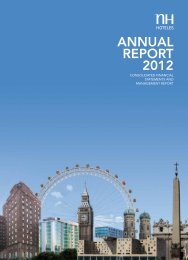Consolidated Financial Statements and Consolidated Management ...
Consolidated Financial Statements and Consolidated Management ...
Consolidated Financial Statements and Consolidated Management ...
You also want an ePaper? Increase the reach of your titles
YUMPU automatically turns print PDFs into web optimized ePapers that Google loves.
31. INFORMATION ON ENVIRONMENTAL POLICY<br />
The management of the integrated water cycle within the Sotogr<strong>and</strong>e development <strong>and</strong> its surroundings forms part of the operations performed by the<br />
Group through Sotogr<strong>and</strong>e, S.A., which include waste water treatment <strong>and</strong> purification to minimise damage to the environment.<br />
As part of its treatment <strong>and</strong> purification operations the Group owns two wastewater treatment plants capable of serving up to 20,000 inhabitants. These plants<br />
are interconnected, so that treated effluent is discharged into the sea through an underwater outfall. These stations are intercommunicated, so that treated<br />
effluents are discharged into the sea through an underwater outfall. Likewise, the Company has built a tertiary treatment system in one of the treatment<br />
stations. This further purifies water, making it suitable to irrigate part of the Real Club de Golf de Sotogr<strong>and</strong>e <strong>and</strong> the pitches of the Santa María Polo Club,<br />
with whom agreements have been signed for this purpose. The tertiary treatment plant has been in service since July 2003. The entry into service of this<br />
tertiary system has increased water resources by 300,000 m³ / year.<br />
Furthermore, the Group is currently focusing its actions on urban l<strong>and</strong> with partially approved plans as part of its promotional <strong>and</strong> development activities<br />
for the Sotogr<strong>and</strong>e Development. In these circumstances, no preliminary environmental impact studies need be conducted on its real estate or tourist<br />
developments. Nonetheless, the Group’s policy aims to achieve maximum respect for the environment, <strong>and</strong> for this purpose it has contracted the services of<br />
an environmental consulting firm to provide environmental diagnoses <strong>and</strong> consulting on the Company’s actions.<br />
The amount of the environmental assets described net of depreciation at 31 December 2011 amounted to 1,467,000 euros (1,523,000 euros in 2010).<br />
The Group had not allocated any provisions for environmental contingencies <strong>and</strong> claims at year-end 2011.<br />
32. EXPOSURE TO RISK<br />
The Group’s financial risk management is centralised at the Corporate Finance Division. This Division has put the necessary measures in place to control<br />
exposure to changes in interest <strong>and</strong> exchange rates on the basis of the Group’s structure <strong>and</strong> financial position, as well as credit <strong>and</strong> liquidity risks. If necessary,<br />
hedges are made on a case-by-case basis. The main financial risks faced by the Group’s policies are described below:<br />
Credit risk<br />
The Group’s main financial assets include cash <strong>and</strong> cash equivalents (see Note 14), as well as trade <strong>and</strong> other accounts receivable (see Note 13). In general<br />
terms, the Group holds its cash <strong>and</strong> cash equivalents in institutions with a high level of creditworthiness <strong>and</strong> part of its trade <strong>and</strong> other accounts receivable<br />
are guaranteed through guarantees, surety <strong>and</strong> advance payments by tour operators.<br />
The Group has no significant concentration of third-party credit risk due to the diversification of its financial investments as well as to the distribution of trade<br />
risks with short collection periods among a large number of customers.<br />
Interest rate risk<br />
The Group’s financial assets <strong>and</strong> liabilities are exposed to fluctuations in interest rates, <strong>and</strong> this may have an adverse effect on its results <strong>and</strong> cash flows. In<br />
order to mitigate this risk, the Group has established policies <strong>and</strong> contracted financial instruments to ensure that approximately 27% of net financial debt is<br />
indexed to fixed interest rates.<br />
In accordance with the reporting requirements set forth in IFRS 7, the Group has conducted a sensitivity analysis on possible interest rate fluctuations in the<br />
markets in which it operates. On the basis of said requirements. The Group is in the process of refinancing its debt through a syndicated loan amounting to 758<br />
million euros, <strong>and</strong> part of its strategy resides in covering at least 25% of the refinanced debt through a hedging instrument yet to be designated (IRS or Collar).<br />
Aside from the impact any changes in the interest rates could have on financial assets <strong>and</strong> liabilities which comprise the net cash position, changes could<br />
arise in the valuation of the financial instrument contracted by the Group (see Note 19). The effects of changes in the interest rates on efficient derivatives<br />
are booked against equity, while the effects on inefficient derivates are booked in the consolidated comprehensive profit <strong>and</strong> loss statement. The Group has<br />
chosen to exclude the temporary value of designating hedges in order to improve their efficiency. Note 19 of the consolidated annual report attached hereto<br />
sets out the sensitivity analysis conducted on the above mentioned derivatives in the faces of changes in interest rates.<br />
Lastly, the long-term financial assets set out in Note 11 of this annual report are also subject to interest rate risks.<br />
Exchange rate risk<br />
The Group is exposed to exchange rate fluctuations that may affect its sales, results, equity <strong>and</strong> cash flows. These mainly arise from:<br />
- Investments in foreign countries (essentially Mexico, Argentina, the Dominican Republic, Colombia, Panama <strong>and</strong> the United States).<br />
- Transactions made by Group companies operating in countries whose currency is other than the euro (essentially Mexico, Argentina, the Dominican<br />
Republic, Venezuela <strong>and</strong> the United States).<br />
In order to ensure these risks are mitigated, the Group has established policies <strong>and</strong> contracted certain financial derivatives (see Note 19). More specifically,<br />
the Group endeavours to align the composition of its financial debt with cash flows in the different currencies. Likewise, financial instruments are contracted<br />
in order to reduce exchange rate differences from transactions denominated in foreign currencies.<br />
The Group has conducted a sensitivity analysis on the possible exchange rate fluctuations that might occur in the markets in which it operates. For this<br />
analysis, the Group has taken into consideration fluctuations in the main currencies with which it operates other than its functional currency (the US dollar, the<br />
Argentine peso, the Mexican peso <strong>and</strong> the Colombian peso). On the basis of this analysis, the Group considers that a 5% depreciation in the corresponding<br />
currencies would have the following impact on equity:<br />
Thous<strong>and</strong> euros<br />
Shareholders’ Equity Profit (Loss)<br />
US dollar (637) (22)<br />
Argentine peso (4,263) (359)<br />
Mexican peso (3,981) (136)<br />
Colombian peso (1,061) 82<br />
REPORT ON THE CONSOLIDATED FINANCIAL STATEMENTS 107






